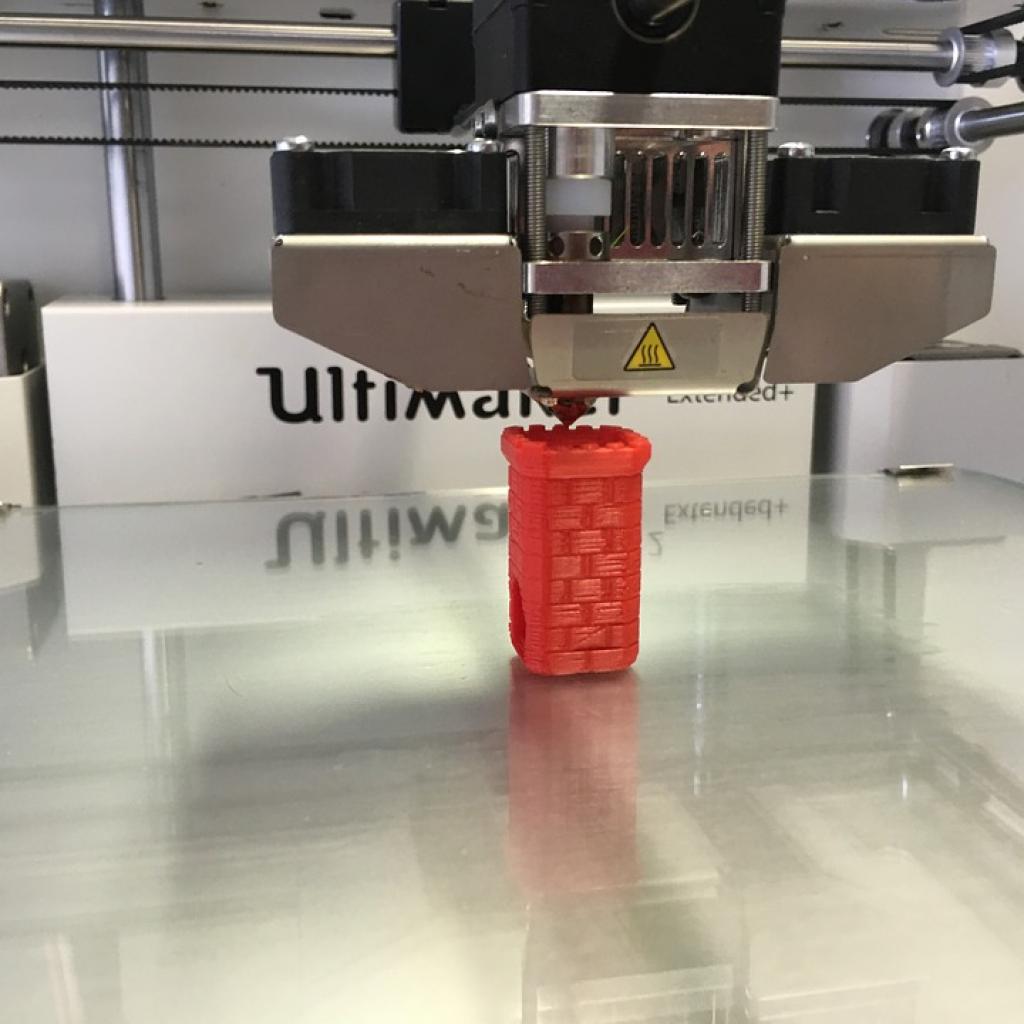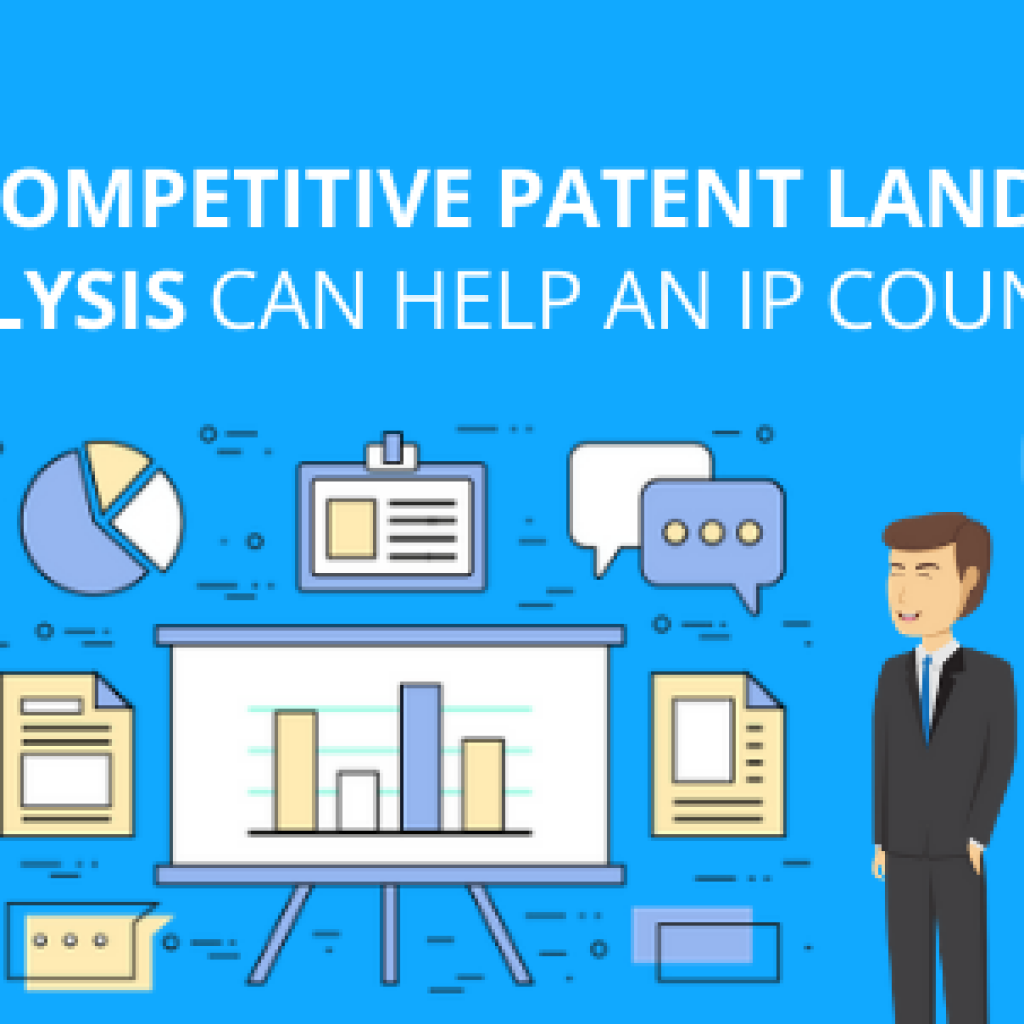Have you ever wondered how Apple, Samsung, and Microsoft emerged as market leaders, despite having thousands of competitors in the technology domain?
The popular notion of their success is believed to be continuous progressive and disruptive innovation.
Though true to an extent, it should be noted that innovation merely can’t contribute to the success of a company, unless measures are taken to protect these innovations from being copied.
This is when patents come into the picture.
Patent portfolios, indeed, are the secret sauce behind the success of these organizations.
But does that mean that an organization can only become successful by innovating and protecting the in-house R&D?
Not really.
It is a well-understood fact that we live an era of technological explosion where hundreds of technologies materialize every year replacing the antique ones. Sticking to a set of technologies and innovating in them for years is not a possibility anymore in a majority of the cases.
To thrive successfully in the business world, it is important to move with the trends. In other words, as better technologies eventuate, the wisdom is in the adoption of those technologies into your product development lifecycle. Having said that, it should be noted that the adoption of technologies into your product lifecycle is – in many cases – complicated.
Relevant Read: The list of Automation Tools that Can Help Craft A Patent Monetization Strategy
We live in the patent-everything-that-is-patentable era. As inventors and researchers around the globe have come to realize the value patents hold, there are very few technologies in existence that are open-source. The first to file race has led to the current system where almost every technology that has surfaced is protected by dozens of patents by the early innovators in the field.
The rules are clear – Anything that’s patented can’t be used unless you’re ready to pay a price.
What are your options when you want to commercialize products but do not have patents to protect the technology?
- Go ahead and infringe on patents as you wish. But make sure you’re ready to pay the infringement royalties when the time comes [We don’t recommend this].
- Seek a license to the patents covering the technology, while acknowledging the risk that your competitors might have a license to the same set of patents, which they could build on to add similar or better set of features in their product line as yours and capture the entire market themselves [Licensing, though a great option, is risky].
- Buy those patents. If the product line in which the patented technology in question has to be leveraged is worth billions in revenue, and you want to keep the competitors at bay, the risk-free solution is to buy those patents.
Is buying patents the optimal solution?
No.
Buying the right set of patents is the optimal solution. You certainly would not want to squander millions in an attempt to buy all the patents concerning the technology without knowing whether they have the potential or not.
Whether you choose the licensing street or the buying lane, you need to invest your assets in the right set of patents. But as simple as it sounds, acquiring the right set of patents is not easy unless you have an in-depth knowledge of the technology and information related to the patents, products, and prototypes built on it.
“Sounds like a boulder to me. What do I do now?” – Is that what you’re thinking?
If yes, there’s nothing to fret about as this boulder can easily be moved. The solution, in this case, is getting a technology scouting done.
What is technology scouting?
Technology scouting could be defined as a way of finding, analyzing and evaluating all existing inventions that are necessary to start, complement or accelerate the development of a new technology/product.
The process of scouting reveals all the major facets related to a technology – be it in the form of key patents, competitor’s activity in the domain, research activity by universities or the overall activity of organizations from the conception of technology.
Each of these facets reveals key insights that can help an organization determine the patents that are worth being sought.
Benefits of Technology Scouting
Not just that, it offers various other advantages. We have listed the key advantages of technology scouting below. If you’d like to jump to a particular benefit, you can do so by clicking on the relevant hyperlink. However, to get the best overview of the advantages, we recommend going through the entire list.
Technology scouting could help:
- Identify the innovators in a domain
- Identify Universities researching in the domain
- Understand Collaborations Between Universities & Companies
- Identify Trends From Technology Clusters
- Understand The Most & Least Innovated Areas In A Technology
- Identify Key patents
- Identify Trends In A Particular Geography
Identify the Innovators in a Domain
Among the multiple facets revealed during a technology scouting, one of them is the identification of organizations innovating in the technology domain. Be it the early innovators or companies that have ventured lately, the patent filing trend data can give precious clues about the portfolios that could be acquired.
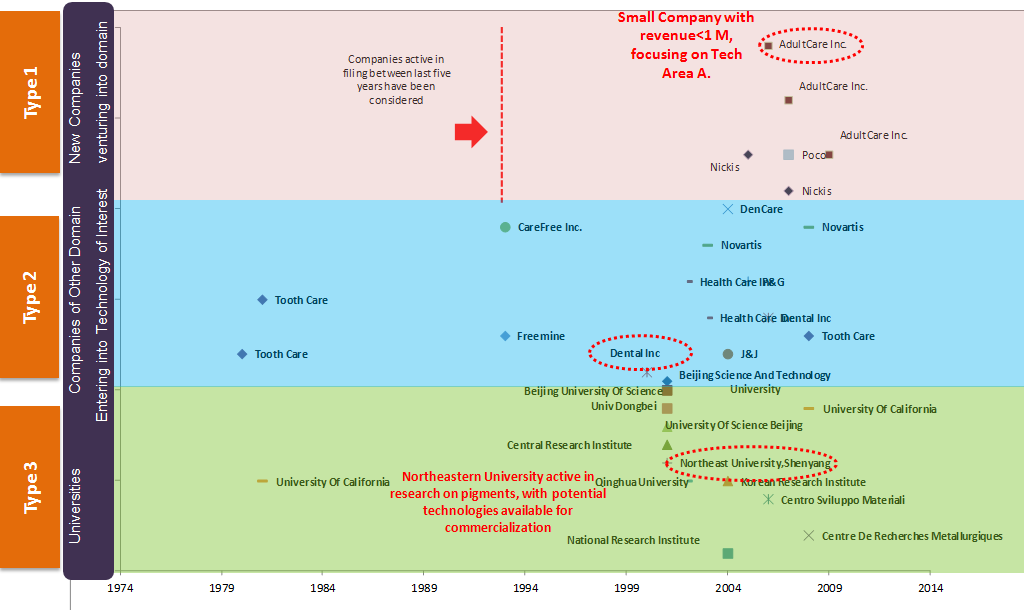
For instance, consider the above example in which the innovators of a particular healthcare technology are identified. The chart reveals that Adultcare Inc, a fairly new company has been proactively innovating in the technology of interest along with several other companies.
The search also revealed that the company has revenue lesser than a million, which clearly indicates that it is a small fish in the lake. But, the in-depth analysis of its patent portfolio hints that this small fish is a Red Lionfish. This means when the time comes, it can use its resources (Patents, in this case) and emerge as a winner.
It stands to reason that the acquisition of the patent portfolio of Adultcare would not be really difficult considering that the company is still very small. Compared to the other innovators in the domain with equally mighty portfolios and huge revenues, the patents of Adultcare would help strengthen your defense systems at a comparatively lower cost.
“Get that fish into the tank” That would be your response, isn’t it?
Small organizations with mighty portfolios are indeed great acquisition options.
Identify Universities researching in the domain
It is often seen that other than organizations, Universities are a great hotspot for innovation. With hundreds of professors and students researching on innumerable fields and coming up with novel theories and innovations, it ain’t a matter of wonder when a new technology claims its origins to the research laboratories of universities.
When the talk is on early innovators, it would not be a wise move to skip universities from the list. During the technology scouting process, all the universities researching the technology of interest are considered. Research matrices are studied to figure out the professors working in a particular technology and databases are searched to find if the particular technology – if been – innovated upon by the university is available for commercialization or not.

For instance, consider that the technology in question is Nanosheets – a branch of nanotechnology. A look at the flintbox database reveals that a lot of the innovation done in the field is by universities. Based on the invention of interest, the technology commercialization department could be contacted and the technology could be licensed/acquired.
Is that the only data technology scouting provides related to universities?
No. There is more.
Understanding Collaborations between Universities and Companies
Technology scouting also unravels the liaisons among institutes and universities which if leveraged can help organizations take better strategic decisions.
For instance, consider that the technology in question is automotive engineering. The scouting data revealed that Tokai University filed multiple patents in joint ownership with Nippon until 2000.
It is a known fact that universities can’t possibly license the technologies which are developed during collaboration, as companies (with whom collaboration agreements are signed) own the exclusive licenses. But if collaboration is not active anymore, there aren’t any restrictions on universities to continue innovating in a similar direction.
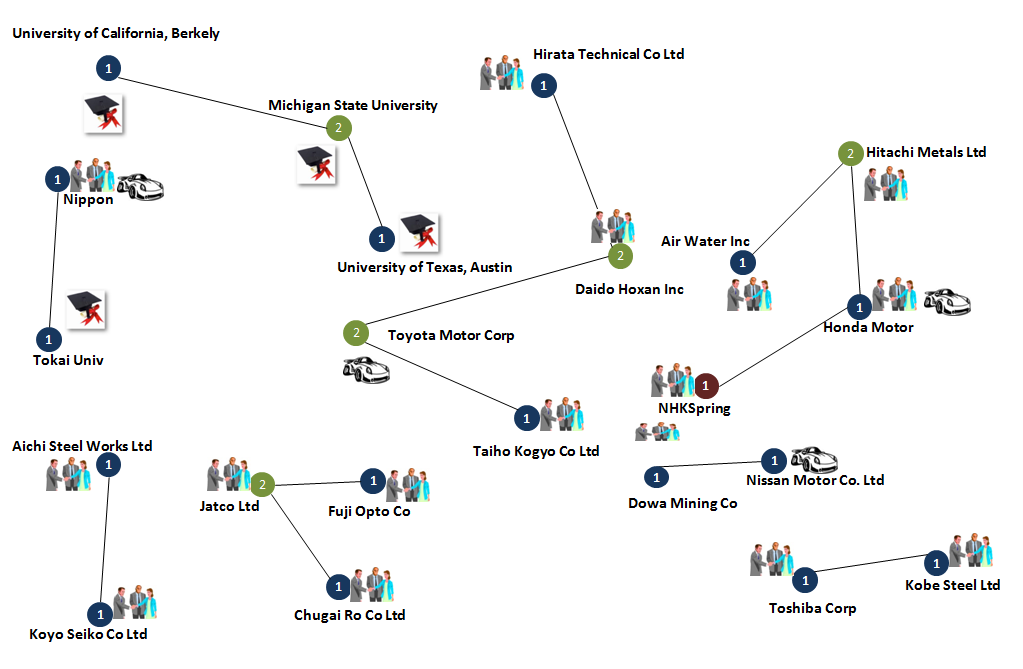
In the Nippon-Tokai university case where the collaboration is not active anymore, Tokai University serves as a great lead for research. If not developed in-house, collaborations can be signed with such leads, as universities already have the history and the resources to continue innovating in the direction.
Identify Trends from Technology Clusters
The study of technology clusters can give insights into the features where a potential market lies or properties that are currently in the maturity phase with little scope for growth.
For instance, consider the below chart which highlights the patent filing activity related to processes and properties of waste treatment. It is evident from the data that Fluid bed combustion for dioxin decomposition is a much-researched area and had seen tremendous growth, whereas the secondary combustion retention taking heat recovery property into account is a declining area.
Growth could be noticed in secondary combustion retention, taking the improved maintenance property into account. Additionally, a study conducted by McKinsey revealed that this very technology is supposed to grow 10 fold by the end of 2020. For companies dealing with waste treatment, this data can be a flag indicating – “This is the area you should invest your R&D dollars in, to reap benefits in future.”
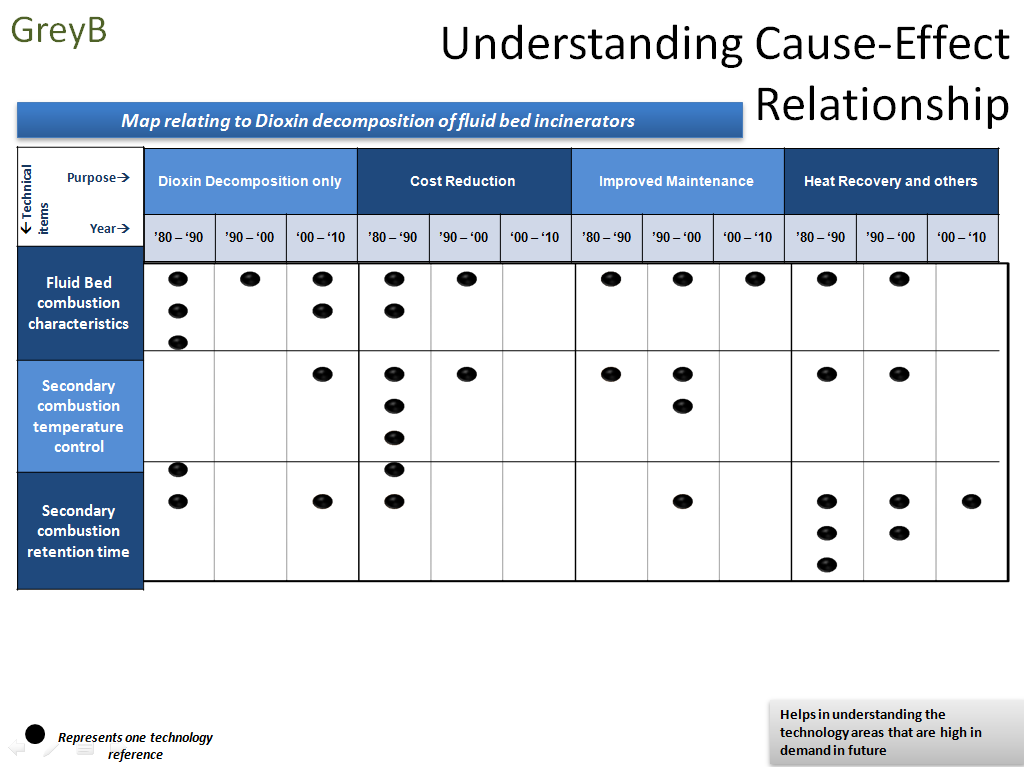
Understanding the Most & Least Innovated Areas in a Technology
Analysis of technology clusters does not just reveal data like potential markets or emerging technologies but also gives a glimpse of the white spaces in the technological area where innovation can be done.
For instance, consider the scouting conducted on steel manufacturing technology. The analysis of technology clusters reveals that a majority of patents were filed in the machines and process enhancement category from 2005 onwards, amongst which the majority were filed in the process utility devices and rolling process domain respectively.
Now, a further dissection on the rolling process cluster revealed that the maximum patents were filed in the cold rolling process domain among the other subdomains. But the interesting facet of the scouting process is that least innovated areas or whitespaces in technology are also excavated.
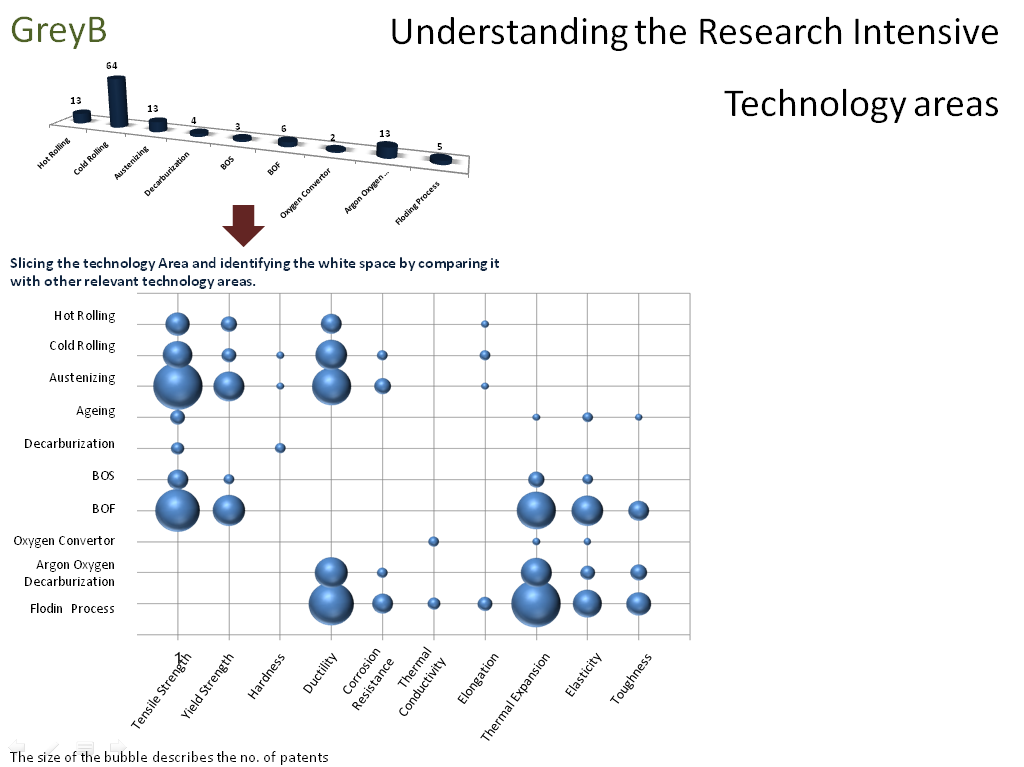
Why is that interesting?
If you had been working in the IP domain for long enough, you’d definitely be aware of the toll gate strategy. Tollgate strategy works only when you join the innovator race pretty early in a technology field, and this would become a possibility if you are aware of whitespaces. In short, figuring out the white spaces can give an edge to your organization in the market when that particular technology covered by the whitespace takes off.
Did you know: Other than toll gate strategy, there are a lot more patent portfolio strategies that you could leverage to build a portfolio that suits your needs. If you’d like to know what those strategies are, this article ought to be on your reading list – The art of smart patent filing strategies.
Getting back to our example, it was found that innovation in the elongation property among the rolling process gained tremendous growth in the past few years. The analysis of the innovators also revealed that other than the top players in the domain, small companies like Daido Inc. were an active part of the race.
It should be noted here that since Daido is one among the early innovators, if they have a very strong patent portfolio (which could be revealed by a patent portfolio analysis), Daido could qualify as a great lead for patent acquisition for these technologies.
Identify Key Patents
What is the real reason behind conducting technology scouting?
To identify the right set of patents for acquisition.
What forms the ideal set?
Key patents.
Key patents of a technology are some of the best candidates for acquisition, and that’s one reason why the identification of key patents is a highlight of a tech scouting report. The key patent analysis takes various factors into account like coverage of claims, current or future infringement potential, the scope of patents, family size etc.
The beauty of the scouting process is that all the key patents are identified and also the current status of the patent is taken into account. For instance, if a technology under study has all the key patents expired, it is an indicator that innovation/penetration in the domain will not be heavy on the pocket.
Recommended Read: Would you like to know ways in which you could generate high ROI producing key patents in-house? If yes, this article is a must read- How to File High ROI Generating Patents?
Identify Trends in a Particular Geography
Key patents, innovation-related information of a domain, whitespace analysis and technology trends are the highlights of a technology scouting report.
But it is often the case that you do not need all the above-mentioned data from worldwide and would rather need the information for a particular geography.
Consider the case when you, as a company, would want to venture into a new country, which would be a new market for your products/services. Prior the venture, it is absolutely essential to understand the market and trends (especially IP related) as you would like to understand your competition and the significant barriers that might prevent your entry in the market.
Geographical trend analysis serves the purpose of providing key innotection (Innovation+protection) information for a particular geography.
Let us try to understand this with an example. Sticking to our earlier mentioned example, the scouting of the steel manufacturing technology area revealed that Japan ranked as the top priority country followed by the Soviet Union and the United States.
If a company, say X, wants to expand its operations to Japan, the first thing to do is dig deep and identify trends related to the particular geography – Japan. The micro-level analysis reveals critical data like the top inventors, top assignees, filing trend and market growth in Japan. The interesting fact to note in this study was that Hitachi Ltd – The largest assignee had its entire portfolio related to the domain expired whereas the other assignees have comparatively smaller portfolios.
Though it is unknown whether Hitachi had any of the key patents or whether the key patents rest with the other players in the domain, a tech scouting report focusing on a particular geographical area is inclusive of all these details.
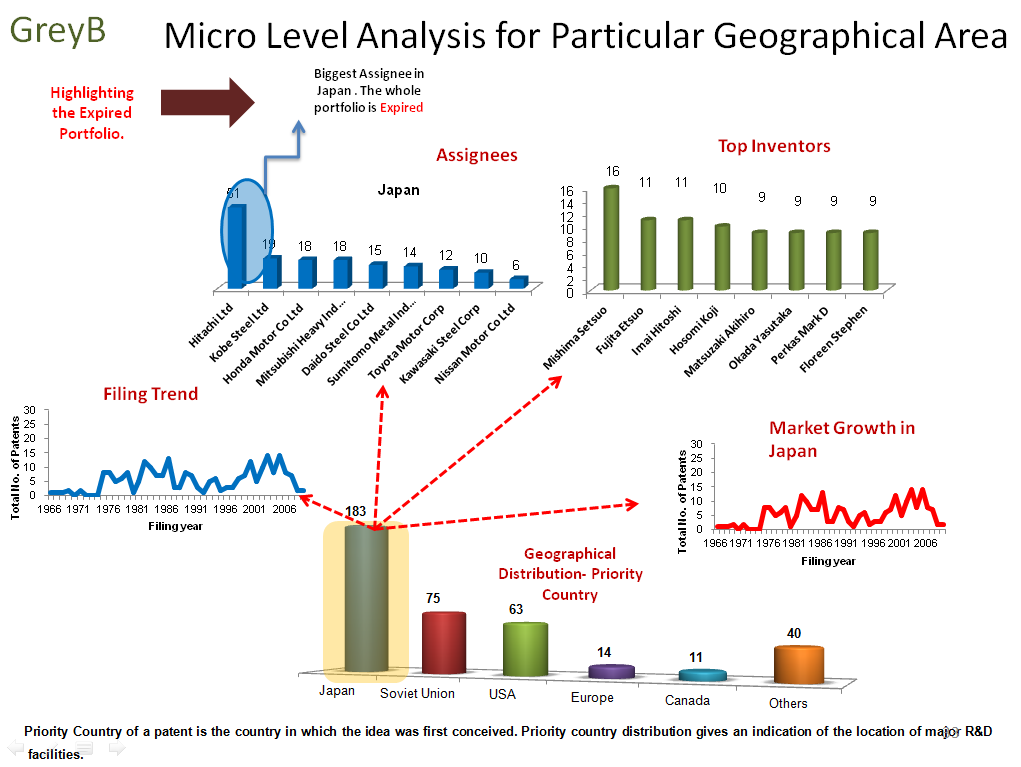
This gets us to the end of our list. We had a look at some of the highlights of a technological scouting report and the advantage it offers. Conducting a technology scouting can give an edge to your organization, helping you secure a holistic patent portfolio while having a firm grasp of the state of innovation in your domain of interest. If you’d like to get scouting conducted for your domain of technology, we can help you.

Recommended Read: Technology scouting can give a lot of insights, which if leveraged on, could help you reach great heights. Yet, have you ever wondered how the person behind the job, a technology scout, feels about the job and the techniques involved? In a beautiful poem penned by a fellow Greybian, we offer a glimpse of the life of a technology scout. Read the poem here – Life of a Technology Scout.







